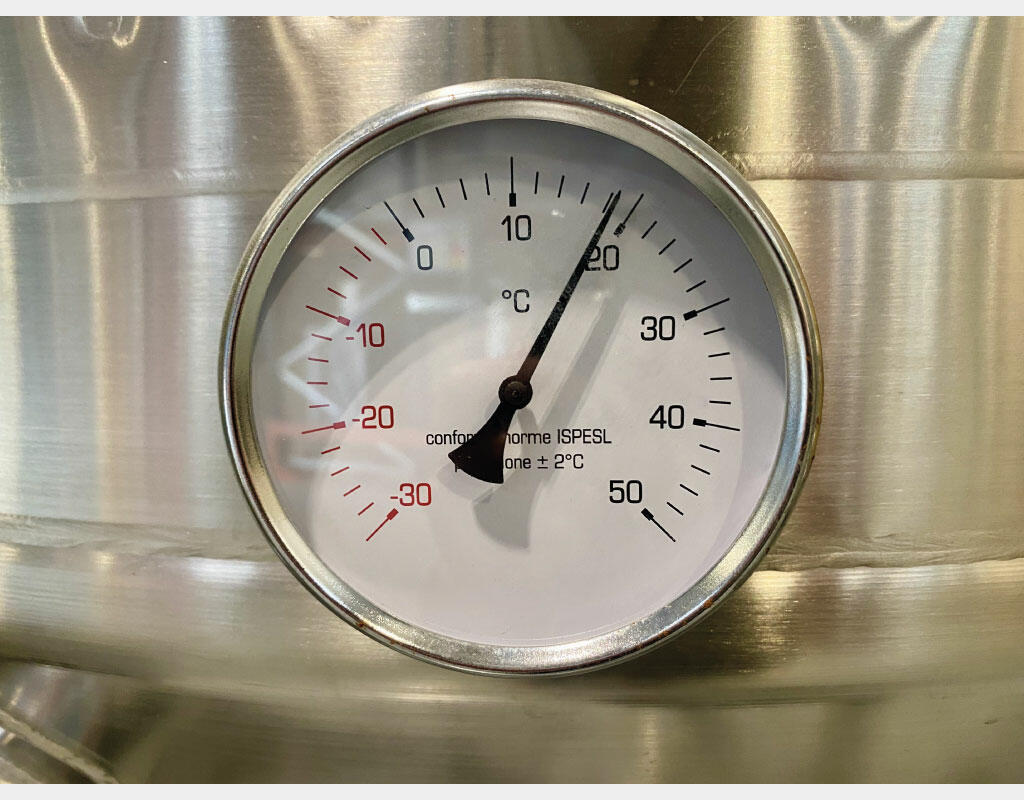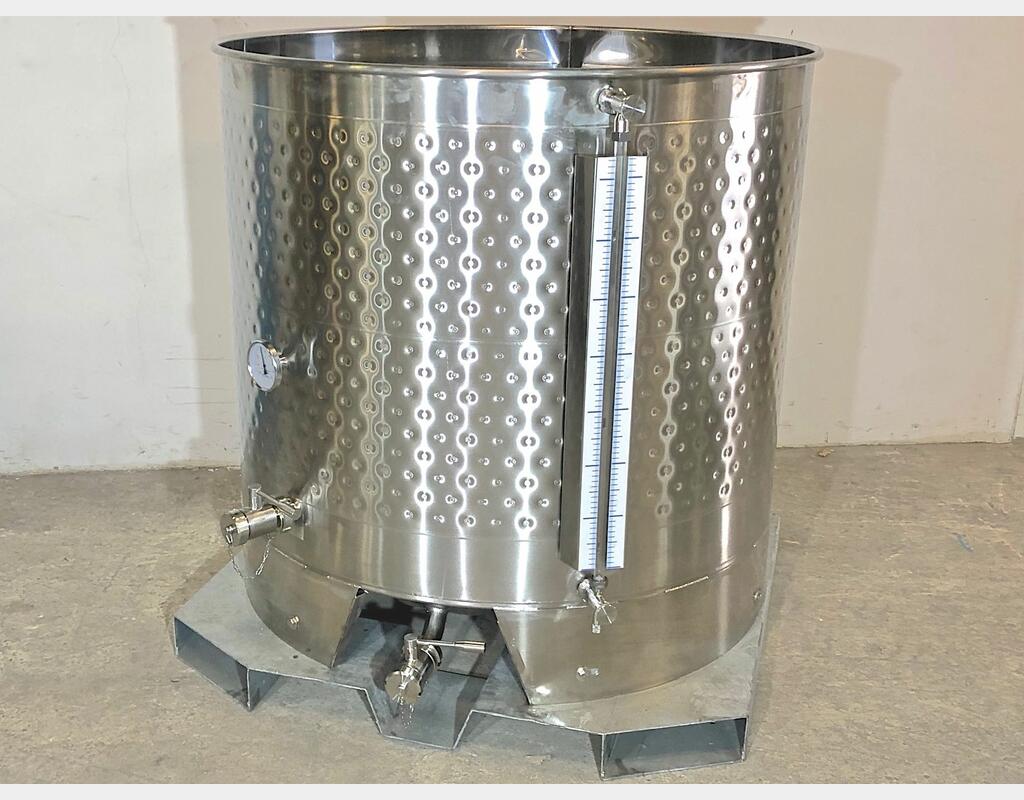Impact of domes on stainless steel tanks in winemaking
Comparison of open,
and with a floating cap
Winemaking is a complex and technical process, where every detail counts to obtain a quality wine. Stainless steel tanks, renowned for their durability, corrosion resistance and ease of maintenance, are ubiquitous in modern wineries. But did you know that the type of dome used on these tanks can profoundly influence the fermentation process and, consequently, the final characteristics of the wine? Whether you opt for an open, closed or floating top tank, each of these models has a direct impact on oxygen exposure, temperature control and internal pressure management. In this article, we decipher the advantages and disadvantages of each type of dome to optimise winemaking, from reducing oxidation to optimising the management of fermentation gases.
Open TANKS : a traditional method for red wines with character
In the red wine vinification process, open vats occupy a special place, particularly for producers seeking to obtain wines with complex, well-structured aromas. Without lids, these vats allow direct interaction with the ambient air, creating natural micro-oxygenation. This exposure is ideal for biodynamic wines or those produced using more traditional winemaking methods, where the aim is to maximise natural interactions. Pigeage, or immersion of the cap of marc, is facilitated by this type of vat, allowing better maceration and more efficient extraction of the phenolic compounds that are essential to the wine's richness.
However, this method requires careful management. While oxygen helps structure the tannins, too much can cause undesirable oxidation, affecting the final quality of the wine. What's more, the absence of a lid requires impeccable hygiene to avoid the proliferation of micro-organisms that could disrupt the fermentation process.
Advantages
- Promotes spontaneous fermentation and optimal maceration, ideal for natural wines.
- Allows for greater extraction of aromas and tannins, resulting in rich, complex red wines.
- Suitable for biodynamic wines and artisanal techniques, where contact with the air is required.
Disadvantages
- Risque d'oxydation si la gestion de l'air n'est pas contrôlée.
- Increased monitoring required to avoid microbial contamination.
- May lead to increased evaporation of the wine, affecting the concentration of compounds.
→ Discover the open vats available in stock
 |
| Belon stainless steel 304 - 73 HL |
Closed tanks : preserving aromas and controlling fermentation
In modern winemaking, closed tanks are an essential asset for winemakers wishing to control every aspect of the fermentation process. These hermetically sealed tanks, mainly used for white and sparkling wines, reduce exposure to oxygen to a minimum, preserving delicate aromas while avoiding the risk of oxidation. Particularly for grape varieties such as Chardonnay or sparkling wines such as Champagne, this method preserves the freshness and liveliness so sought-after.
Closed tanks are also prized for their ability to control temperature and pressure, crucial elements for anaerobic fermentation (without oxygen) and the creation of fine bubbles in sparkling wines. Thanks to this technology, it is possible to precisely adjust the conditions inside the tank, guaranteeing a high-quality end product.
Advantages
- Prevention of oxidation: By minimising contact with oxygen, these tanks guarantee fresh, lively aromas, which are particularly important for white and sparkling wines.
- Precise control of fermentation: Temperature and pressure regulation enables fermentation to be controlled with great precision, essential for quality sparkling wines.
- Suitable for delicate wines: Ideal for grape varieties such as Sauvignon Blanc, Riesling and Chardonnay, where preserving aromas and freshness is paramount.
Disadvantages
- Limited interaction with air: Less oxygen means that certain complex aromas, often sought after in aged red wines, may be less present.
- Increased monitoring: These tanks require advanced technology and constant monitoring to ensure optimum fermentation conditions.
→ Discover the closed tanks available in stock
 |
| 304 ss tank - 25 HL |
Floating top tanks : flexible oxygen management
Floating top tanks offer an innovative and adaptable solution for winemaking. Equipped with a movable roof that adjusts to the liquid level, these tanks allow precise control of the wine's exposure to oxygen throughout the fermentation and ageing process. This intelligent mechanism prevents air from entering the tank as the volume of wine decreases, ensuring constant protection against oxidation, which is particularly important for white and rosé wines with delicate aromas.
One of the major advantages of these tanks is their ability to partially replace the use of inert gases, such as nitrogen or CO2, traditionally used in closed tanks to protect the wine from the harmful effects of oxygen. This translates into lower production costs, while offering winemakers the possibility of adjusting the level of protection according to the specific needs of each phase of the wine.
How the floating cap works
The floating cap descends as the volume of liquid decreases, creating a physical barrier between the wine and the air. This flexibility means that exposure to oxygen can be modulated dynamically, adapting the parameters according to the stages of fermentation or maturation of the wine.
→ Discover the guide to installing floating caps
Advantages
- Adjustable oxygen control: Ideal for the fermentation of white and rosé wines, this technology minimises the risk of oxidation while adapting exposure as required.
- Reduced costs: By limiting the use of inert gases, winemakers can save money while maintaining optimum control of the winemaking process.
- Versatility: Suitable for both still and sparkling wines, and even for certain reds requiring precise adjustment of air exposure.
Disadvantages
- Mechanical complexity: The floating bonnet system requires rigorous maintenance and precise adjustments to ensure maximum efficiency.
- Increased monitoring required to avoid microbial contamination.
- Handling risks: Poor fit of the cap or mechanical failure can compromise the integrity of the wine, leading to unwanted oxidation or contamination.
→ Discover the floating top tanks available in stock
 |
| 304 ss tank -22.9 HL |
Open tanks : a traditional method for red wines with character
The choice of dome for your stainless steel tanks plays a decisive role in the winemaking process, and can have a considerable influence on the quality and aromatic profile of your wines. Each type of tank offers unique advantages: the open tank allows optimum extraction of tannins for powerful red wines, the closed tank ensures that the delicate aromas of white and sparkling wines are preserved, while the floating top tank offers a versatile solution, adapting to specific needs such as oxygen management for rosés or certain whites.
Taking into account your oenological objectives and the specific characteristics of your wines, it is essential to select the right tank to optimise the winemaking process. Whether you are looking to intensify tannin extraction or preserve freshness and delicate aromas, Arsilac offers a range of innovative stainless steel tanks designed to meet the requirements of the most demanding winemakers.
To find out which tank is best suited to your needs, don't hesitate to contact the experts or consult the catalogue. Arsilac can help you optimise your winemaking processes, combining tradition and innovation.
#cuve #inox #chapeauflottant #plafondmobile #cuveouverte #cuvefermee






